The Economics and Statistics Division maintains archives of previous publications for accountability purposes, but makes no updates to keep these documents current with the latest data revisions from Statistics Canada. As a result, information in older documents may not be accurate. Please exercise caution when referring to older documents. For the latest information and historical data, please contact the individual listed to the right.
<--- Return to Archive
For additional information relating to this article, please contact:
July 27, 2021POLICE REPORTED CRIME STATISTICS, 2020 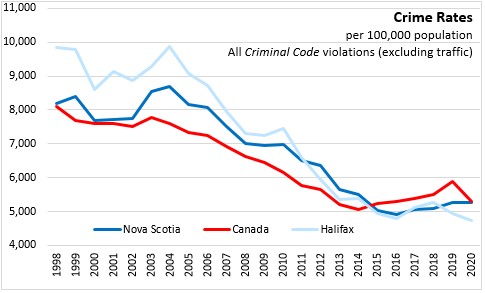
Statistics Canada has released the 2020 results for police-reported crime statistics collected under the Uniform Crime Reporting Survey. This report measures incidents of crime, crime rates (per 100,000 population), and crime severity (based on sentencing data) by types of crime.
Canada's crime rate (Criminal Code violations excluding traffic) was 5,301 incidents per 100,000 population. In comparison, Nova Scotia's crime rate for 2020 was 5,256 per 100,000 population. The lowest crime rates among provinces were in Quebec and Ontario.
Halifax's crime rate fell to 4,730 incidents per 100,000 population.
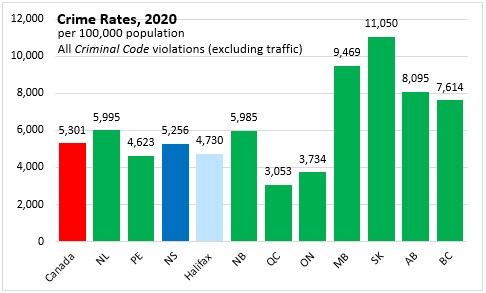
Nova Scotia's crime rate (Criminal Code, excluding traffic) decreased 0.4% in 2020, while there was a 4.2% decline in Halifax. This is the first decline in Nova Scotia's crime rate since 2016.
Canada's crime rate fell by 9.8% in 2020. Statistics Canada noted that imposition of COVID-related restrictions kept many people at home for longer periods, reducing opportunities for several types of crime. Across Canada, crime rates were lower in all provinces except Newfoundland and Labrador.

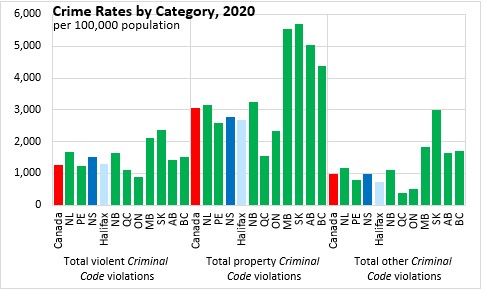
In 2020, there were 35 homicides in Nova Scotia, 29 more than in 2019. In April 2020, 22 people were killed and 3 others were injured in a mass shooting, the deadliest in Canadian history.
In Nova Scotia' there were 1,503 violent Criminal Code violations per 100,000 residents in 2020, including April's mass shooting. The national violent crime rate was 1,254 violations per 100,000 residents.
There were 2,776 property violations per 100,000 residents in Nova Scotia and 978 other Criminal Code violations. Nationally, there were 3,071 property violations and 977 other Criminal Code violations per 100,000 residents.
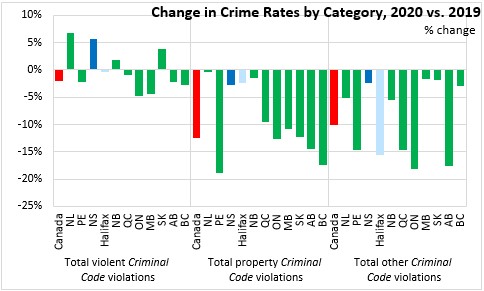
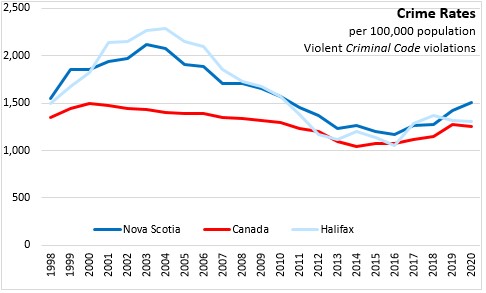
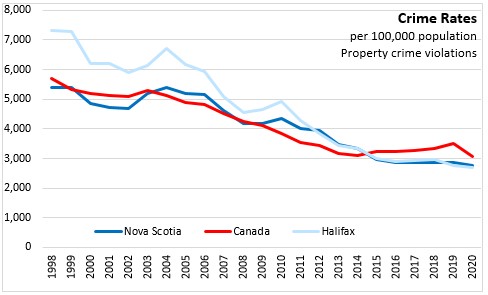
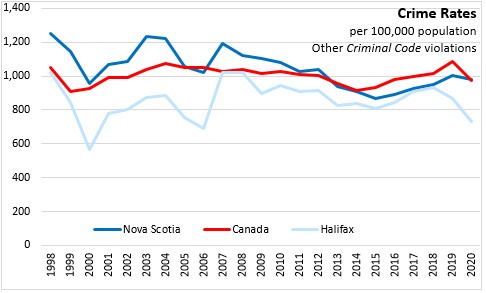
In the last year, the violent crime rate was up 5.7% in Nova Scotia, including the mass shooting in April. The rate of violent crime decreased 0.4% in Halifax and 2.0% nationally.
Property crime rates were down 2.7% in Nova Scotia and 2.4% in Halifax while the national property crime rate decreased by 12.6%. Other Criminal Code violations were down 2.3% in Nova Scotia, down 15.7% in Halifax and down 10.2% nationally.
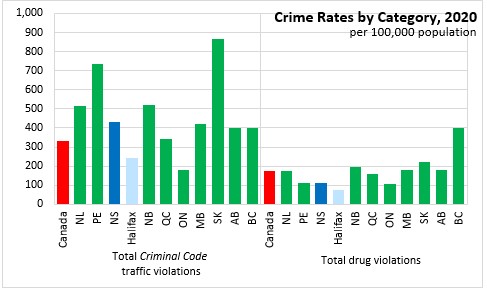
Nova Scotia reported 432 Criminal Code traffic violations per 100,000 residents in 2020, which was above the national average of 330. There were 241 Criminal Code traffic violations per 100,000 residents in Halifax.
Nova Scotia's drug violation rate was 111 per 100,000 residents while Halifax's was 75. The national drug violation rate was 176 per 100,000 residents.
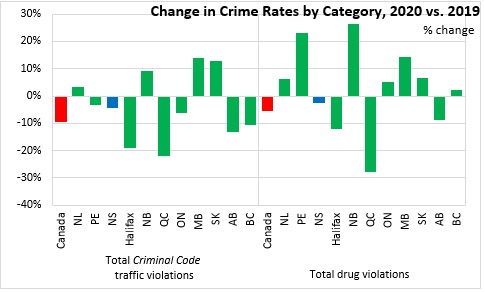
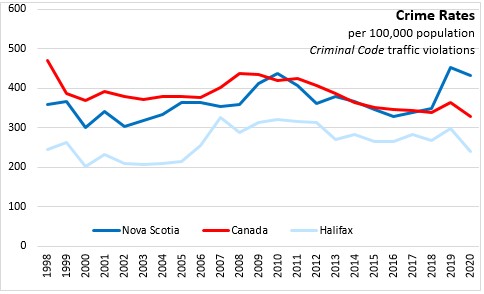
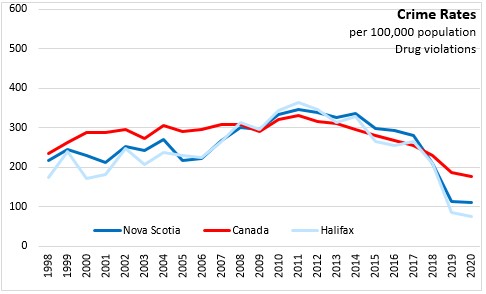
The rate of Criminal Code traffic violations decreased by 4.4% in Nova Scotia in 2020 (-18.9% in Halifax), which was outpaced by the national decline of 9.6%. The rate of drug violations was down 2.5% (-12.1% in Halifax) in 2020. The rate of drug violations was down 5.5% nationally.
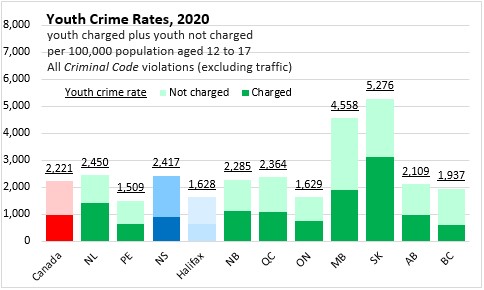
Nova Scotia's youth crime rate in 2020 was 2,417 violations per 100,000 residents aged 12-17, which was higher than the national youth crime rate (2,221). The youth crime rate was lower in Halifax (1,628). Youth crime rates were higher in Manitoba and Saskatchewan. Note the youth crime rates are divided into youth who are charged for a reported crime and youth who are not charged for a reported crime.
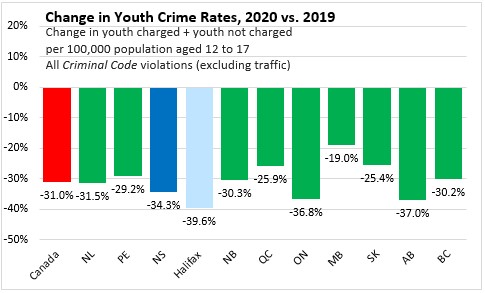
The youth crime rate declined 34.3% in Nova Scotia (-39.6% in Halifax) while the national youth crime rate declined 31.0%. Youth crime rates were down substantially in all provinces from 2019 to 2020.
The overall severity of crime, as measured by the Total Crime Severity Index (CSI), increased 7.9% for Nova Scotia, (+1.6% for Halifax) in 2020. A substantial portion (40%) of the increase in Nova Scotia's crime severity was due to the mass shooting in April.
Nationally, the Total CSI decreased 7.9% in 2020, the first decline after five years of growth. The severity of violent crime increased 18.5% in Nova Scotia, though it was down 0.4% for Halifax. National violent crime severity decreased 3.6% in 2020. Non-violent crime severity was up 2.6% in Nova Scotia, 2.7% in Halifax and down 9.8% nationally.
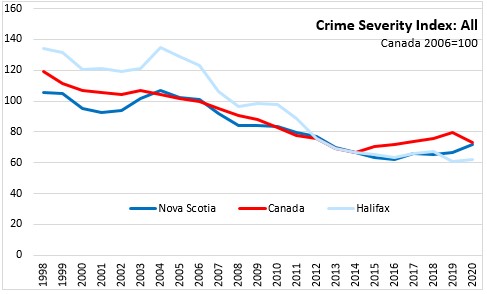

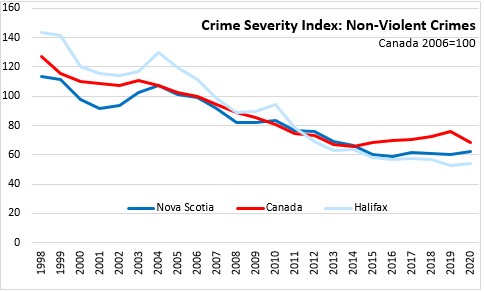
NOTE: on January 1, 2018, Statistics Canada, in collaboration with police, changed the definition of “founded” criminal incidents. With the new definition, there is the potential that police will classify more incidents as founded.
Source: Statistics Canada. Table 35-10-0026-01 Crime severity index and weighted clearance rates, Canada, provinces, territories and Census Metropolitan Areas, Table 35-10-0177-01 Incident-based crime statistics, by detailed violations, Canada, provinces, territories and Census Metropolitan Areas
<--- Return to Archive